Reducing Seed Shattering in Weedy Rice by Editing SH4 and qSH1 Genes: Implications in Environmental Biosafety and Weed Control through Transgene Mitigation
Abstract
Simple Summary
Abstract
1. Introduction
2. Materials and Methods
2.1. Production of SH4 and qSH1 Gene-Edited Plants
2.2. Measurement of Seed Shattering- and Seed Size-Related Traits of Gene-Edited and Control Lines
2.3. Electronic Microscopy of Pedicels of Gene-Edited and Parental Weedy Rice Lines
2.4. Transcriptomic Sequencing of the Gene-Edited and Parental Weedy Rice Lines
2.5. Real-Time Quantitative PCR of Genes Related to the Seed Shattering of Weedy Rice
2.6. Examination of the Shattering-Related Hormone Contents of Gene-Edited and Parental Weedy Rice Lines
2.7. Data Analysis
3. Results
3.1. Variation in Seed Shattering- and Seed Size-Related Traits in SH4- and qSH1-Edited Weedy Rice Plants
3.2. Transcriptomic Analyses of SH4- and qSH1-Edited Weedy Rice Plants and the Control
3.3. Expression Patterns of the Seed Shattering-Associated Genes and the Content of Plant Hormones
4. Discussion
4.1. Editing the SH4 or qSH1 Gene Substantially Reduces Seed Shattering with Limited Influences on Seed Size-Related Traits of Weedy Rice
4.2. Editing SH4 and qSH1 Genes Regulates the Expression of Seed Shattering-Related Genes and Biosynthesis of the Key Hormone in Weedy Rice
4.3. Implications for Environmental Biosafety and Weedy Rice Control through Mitigating Genes Transmitted from Cultivated Rice
5. Conclusions
Supplementary Materials
Author Contributions
Funding
Data Availability Statement
Conflicts of Interest
References
- ISAAA. Global status of commercialized biotech/GM crops in 2019: Biotech crops drive socio-economic development and sustainable environment in the new frontier. In ISAAA Brief No. 55; ISAAA: Ithaca, NY, USA, 2019. [Google Scholar]
- Ebenezer, K.S.; Velu, R.K. Persistence and enzymatic activities assessments of larvicidal crystal proteins from Bacillus thuringiensis bollgard II cotton in bioinoculant rhizosphere soils. Int. J. Adv. Res. 2015, 3, 555–562. [Google Scholar]
- Lamichhane, J.R.; Devos, Y.; Beckie, H.; Owen, M.D.K.; Tillie, P.; Messéan, A.; Kudsk, P. Integrated weed management systems with herbicide-tolerant crops in the European Union: Lessons learnt from home and abroad. Crit. Rev. Biotechnol. 2016, 37, 459–475. [Google Scholar] [CrossRef] [PubMed]
- Li, Y.; Zhang, Q.; Liu, Q.; Meissle, M.; Yang, Y.; Wang, Y.; Hua, H.; Chen, X.; Peng, Y.; Romeis, J. Bt rice in China—Focusing the nontarget risk assessment. Plant Biotechnol. J. 2017, 15, 1340–1345. [Google Scholar] [CrossRef] [PubMed]
- Pandolfo, C.E.; Presotto, A.; Carbonell, F.T.; Ureta, S.; Poverene, M.; Cantamutto, M. Transgene escape and persistence in an agroecosystem: The case of glyphosate-resistant Brassica rapa L. in central Argentina. Environ. Sci. Pollut. Res. 2018, 25, 6251–6264. [Google Scholar] [CrossRef]
- Yang, X.; Wang, F.; Su, J.; Lu, B.-R. Limited Fitness Advantages of Crop-Weed Hybrid Progeny Containing Insect-Resistant Transgenes (Bt/CpTI) in Transgenic Rice Field. PLoS ONE 2012, 7, e41220. [Google Scholar] [CrossRef]
- Wang, W.; Xia, H.; Yang, X.; Xu, T.; Si, H.J.; Cai, X.X.; Wang, F.; Su, J.; Snow, A.A.; Lu, B.-R. A novel 5-enolpyruvoylshikimate-3-phosphate (EPSP) synthase transgene for glyphosate resistance stimulates growth and fecundity in weedy rice (Oryza sativa) without herbicide. New Phytol. 2014, 202, 679–688. [Google Scholar] [CrossRef]
- Lu, B.; Yang, X.; Ellstrand, N.C. Fitness correlates of crop transgene flow into weedy populations: A case study of weedy rice in China and other examples. Evol. Appl. 2016, 9, 857–870. [Google Scholar] [CrossRef]
- Ellstrand, N.C.; Prentice, H.C.; Hancock, J.F. Gene Flow and Introgression from Domesticated Plants into their Wild Relatives. Annu. Rev. Ecol. Syst. 1999, 30, 539–563. [Google Scholar] [CrossRef]
- Stewart, C.N.; Richards, H.A.; Halfhill, M.D. Transgenic Plants and Biosafety: Science, Misconceptions and Public Perceptions. Biotechniques 2000, 29, 832–843. [Google Scholar] [CrossRef]
- Lu, B.-R.; Snow, A.A. Gene Flow from Genetically Modified Rice and Its Environmental Consequences. BioScience 2005, 55, 669–678. [Google Scholar] [CrossRef]
- Lu, B.-R. Transgene escape from GM crops and potential biosafety consequences: An environmental perspective. Collect. Biosaf. Rev. 2008, 4, 66–141. [Google Scholar]
- Eleftherohorinos, I.G.; Dhima, K.V.; Vasilakoglou, I.B. Interference of red rice in rice grown in Greece. Weed Sci. 2002, 50, 167–172. [Google Scholar] [CrossRef]
- Delouche, J.C.; Burgos, N.R.; Gealy, D.R.; de San Martin, G.Z.; Labrada, R. Weedy Rices: Origin, Biology, Ecology and Control; FAO: Rome, Italy, 2007. [Google Scholar]
- Chen, M.; Shelton, A.; Ye, G.-Y. Insect-Resistant Genetically Modified Rice in China: From Research to Commercialization. Annu. Rev. Entomol. 2011, 56, 81–101. [Google Scholar] [CrossRef]
- Sun, G.; Dai, W.; Cui, R.; Qiang, S.; Song, X. Gene flow from glufosinate-resistant transgenic hybrid rice Xiang 125S/Bar68-1 to weedy rice and cultivated rice under different experimental designs. Euphytica 2015, 204, 211–227. [Google Scholar] [CrossRef]
- Engku, A.K.; Norida, M.; Juraimi, A.S.; Rafii, M.Y.; Abdullah, S.A.; Alam, M.A. Gene flow from Clearfield® rice to weedy rice under field conditions. Plant Soil Env. 2016, 62, 16–22. [Google Scholar]
- Chen, L.J.; Lee, D.S.; Song, Z.P.; Suh, H.S.; Lu, B.-R. Gene flow from cultivated rice (Oryza sativa) to its weedy and wild relatives. Ann. Bot. 2004, 93, 67–73. [Google Scholar] [CrossRef]
- Yang, X.; Li, L.; Cai, X.; Wang, F.; Su, J.; Lu, B.-R. Efficacy of insect-resistance Bt/CpTI transgenes in F5–F7 generations of rice crop–weed hybrid progeny: Implications for assessing ecological impact of transgene flow. Sci. Bull. 2015, 60, 1563–1571. [Google Scholar] [CrossRef]
- Jiang, X.-Q.; Yang, X.; Lu, B.-R. Increased Longevity and Dormancy of Soil-Buried Seeds from Advanced Crop–Wild Rice Hybrids Overexpressing the EPSPS Transgene. Biology 2021, 10, 562. [Google Scholar] [CrossRef]
- Shivrain, V.K.; Burgos, N.R.; Anders, M.M.; Rajguru, S.N.; Moore, J.; Sales, M.A. Gene flow between Clearfield (TM) rice and red rice. Crop Prot. 2007, 26, 349–356. [Google Scholar] [CrossRef]
- Kaloumenos, N.S.; Capote, N.; Aguado, A.; Eleftherohorinos, I.G. Red rice (Oryza sativa) cross-resistance to imidazolinone herbicides used in resistant rice cultivars grown in northern Greece. Pestic. Biochem. Physiol. 2013, 105, 177–183. [Google Scholar] [CrossRef]
- Andres, A.; Fogliatto, S.; Ferrero, A.; Vidotto, F. Susceptibility to imazamox in Italian weedy rice populations and Clearfield® rice varieties. Weed Res. 2014, 54, 492–500. [Google Scholar] [CrossRef]
- Merotto, A.; Goulart, I.C.G.R.; Nunes, A.L.; Kalsing, A.; Markus, C.; Menezes, V.G.; Wander, A.E. Evolutionary and social consequences of introgression of nontransgenic herbicide resistance from rice to weedy rice in Brazil. Evol. Appl. 2016, 9, 837–846. [Google Scholar] [CrossRef] [PubMed]
- Yan, H.; Li, L.; Liu, P.; Jiang, X.; Wang, L.; Fang, J.; Lin, Z.; Wang, F.; Su, J.; Lu, B.-R. Reduced weed seed shattering by silencing a cultivated rice gene: Strategic mitigation for escaped transgenes. Transgenic Res. 2017, 26, 465–475. [Google Scholar] [CrossRef] [PubMed]
- Al-Ahmad, H.; Gressel, J. Mitigation using a tandem construct containing a selectively unfit gene precludes establishment of Brassica napus transgenes in hybrids and backcrosses with weedy Brassica rapa. Plant Biotechnol. J. 2006, 4, 23–33. [Google Scholar] [CrossRef] [PubMed]
- Gressel, J. Dealing with transgene flow of crop protection traits from crops to their relatives. Pest Manag. Sci. 2015, 71, 658–667. [Google Scholar] [CrossRef]
- Warwick, S.I.; Stewart, C.N. Crops come from wild plants—How domestication, transgenes, and linkage together shape ferality. In Crop Ferality and Volunteerism; Gressel, J., Ed.; CRC Press: Boca Raton, FL, USA, 2005; pp. 9–30. [Google Scholar]
- Bolger, A.M.; Lohse, M.; Usadel, B. Trimmomatic: A flexible trimmer for Illumina sequence data. Bioinformatics 2014, 30, 2114–2120. [Google Scholar] [CrossRef]
- Du, H.; Yu, Y.; Ma, Y.; Gao, Q.; Cao, Y.; Chen, Z.; Ma, B.; Qi, M.; Li, Y.; Zhao, X.; et al. Sequencing and de novo assembly of a near complete indica rice genome. Nat. Commun. 2017, 8, 15324. [Google Scholar] [CrossRef]
- Pertea, M.; Pertea, G.M.; Antonescu, C.M.; Chang, T.-C.; Mendell, J.T.; Salzberg, S.L. StringTie enables improved reconstruction of a transcriptome from RNA-seq reads. Nat. Biotechnol. 2015, 33, 290–295. [Google Scholar] [CrossRef]
- Livak, K.J.; Schmittgen, T.D. Analysis of relative gene expression data using real-time quantitative PCR and the 2− ΔΔCT method. Methods 2001, 25, 402–408. [Google Scholar] [CrossRef]
- Andrews, F.; Morgan, J.; Sonquis, J.; Klein, L. Multiple Classification Analysis; University of Michigan: Ann Arbor, MI, USA, 1973. [Google Scholar]
- Blalock, H.M. Social Statistics; McGraw-Hill: New York, NY, USA, 1972. [Google Scholar]
- Love, M.I.; Huber, W.; Anders, S. Moderated estimation of fold change and dispersion for RNA-seq data with DESeq2. Genome Biol. 2014, 15, 550. [Google Scholar] [CrossRef]
- Li, C.; Zhou, A.; Sang, T. Rice Domestication by Reducing Shattering. Science 2006, 311, 1936–1939. [Google Scholar] [CrossRef]
- Nunes, A.L.; Delatorre, C.A.; Merotto, A. Gene expression related to seed shattering and the cell wall in cultivated and weedy rice. Plant Biol. 2014, 16, 888–896. [Google Scholar] [CrossRef]
- Yan, H.; Ma, L.; Wang, Z.; Lin, Z.; Su, J.; Lu, B.-R. Multiple tissue-specific expression of rice seed-shattering gene SH4 regulated by its promoter pSH4. Rice 2015, 8, 12. [Google Scholar] [CrossRef]
- Lang, H.; He, Y.; Li, F.; Ma, D.; Sun, J. Integrative hormone and transcriptome analysis underline the role of abscisic acid in seed shattering of weedy rice. Plant Growth Regul. 2021, 94, 261–273. [Google Scholar] [CrossRef]
- Yao, N.; Wang, L.; Yan, H.; Liu, Y.; Lu, B.-R. Mapping quantitative trait loci (QTL) determining seed-shattering in weedy rice: Evolution of seed shattering in weedy rice through de-domestication. Euphytica 2015, 204, 513–522. [Google Scholar] [CrossRef]
- Konishi, S.; Izawa, T.; Lin, S.Y.; Ebana, K.; Fukuta, Y.; Sasaki, T.; Yano, M. An SNP Caused Loss of Seed Shattering During Rice Domestication. Science 2006, 312, 1392–1396. [Google Scholar] [CrossRef]
- Lin, Z.; Griffith, M.E.; Li, X.; Zhu, Z.; Tan, L.; Fu, Y.; Zhang, W.; Wang, X.; Xie, D.; Sun, C. Origin of seed shattering in rice (Oryza sativa L.). Planta 2007, 226, 11–20. [Google Scholar] [CrossRef]
- Inoue, C.; Htun, T.M.; Inoue, K.; Ikeda, K.-I.; Ishii, T.; Ishikawa, R. Inhibition of abscission layer formation by an interaction of two seed-shattering loci, sh4 and qSH3, in rice. Genes Genet. Syst. 2015, 90, 1–9. [Google Scholar] [CrossRef]
- Zhou, Y.; Lu, D.; Li, C.; Luo, J.; Zhu, B.-F.; Zhu, J.; Shangguan, Y.; Wang, Z.; Sang, T.; Zhou, B.; et al. Genetic Control of Seed Shattering in Rice by the APETALA2 Transcription Factor SHATTERING ABORTION1. Plant Cell 2012, 24, 1034–1048. [Google Scholar] [CrossRef]
- Lin, Z.; Li, X.; Shannon, L.M.; Yeh, C.-T.; Wang, M.L.; Bai, G.; Peng, Z.; Li, J.; Trick, H.N.; Clemente, T.E.; et al. Parallel domestication of the Shattering1 genes in cereals. Nat. Genet. 2012, 44, 720–724. [Google Scholar] [CrossRef]
- Yoon, J.; Cho, L.-H.; Kim, S.L.; Choi, H.; Koh, H.-J.; An, G. The BEL1-type homeobox gene SH5 induces seed shattering by enhancing abscission-zone development and inhibiting lignin biosynthesis. Plant J. 2014, 79, 717–728. [Google Scholar] [CrossRef] [PubMed]
- Yoon, J.; Cho, L.-H.; Antt, H.W.; Koh, H.-J.; An, G. KNOX protein OSH15 induces grain shattering by repressing lignin biosynthesis genes. Plant Physiol. 2017, 174, 312–325. [Google Scholar] [CrossRef] [PubMed]
- Roberts, J.A.; Elliott, K.A.; Gonzalez-Carranza, Z.H. Abscission, dehiscence, and other cell separation processes. Annu. Rev. Plant Biol. 2002, 53, 131–158. [Google Scholar] [CrossRef] [PubMed]
- Ogawa, M.; Kay, P.; Wilson, S.; Swain, S.M. Arabidopsis Dehiscence Zone Polygalacturonase1 (ADPG1), ADPG2, and QUARTET2 Are Polygalacturonases Required for Cell Separation during Reproductive Development in Arabidopsis. Plant Cell 2009, 21, 216–233. [Google Scholar] [CrossRef]
- Rijavec, T.; Kovac, M.; Kladnik, A.; Chourey, P.S.; Dermastia, M.A. comparative study on the role of cytokinins in caryopsis development in the maize miniature1 deed mutant and its wild type. J. Integr. Plant Biol. 2009, 51, 840–849. [Google Scholar] [CrossRef]
- Ishimaru, K.; Hirotsu, N.; Madoka, Y.; Murakami, N.; Hara, N.; Onodera, H.; Kashiwagi, T.; Ujiie, K.; Shimizu, B.-I.; Onishi, A.; et al. Loss of function of the IAA-glucose hydrolase gene TGW6 enhances rice grain weight and increases yield. Nat. Genet. 2013, 45, 707–711. [Google Scholar] [CrossRef]
- Zhang, X.; Tong, J.; Bai, A.; Liu, C.; Xiao, L.; Xue, H. Phytohormone dynamics in developing endosperm influence rice grain shape and quality. J. Integr. Plant Biol. 2020, 62, 1625–1637. [Google Scholar] [CrossRef]
- Fukagawa, N.K.; Zisk, L.H. Rice: Importance for global nutrition. J. Nutr. Sci. Vitaminol. 2019, 65, S2–S3. [Google Scholar] [CrossRef]
- Yang, X.; Li, L.; Jiang, X.; Wang, W.; Cai, X.; Su, J.; Wang, F.; Lu, B.-R. Genetically engineered rice endogenous 5-enolpyruvoylshikimate-3-phosphate synthase (epsps) transgene alters phenology and fitness of crop-wild hybrid offspring. Sci. Rep. 2017, 7, 6834. [Google Scholar] [CrossRef]
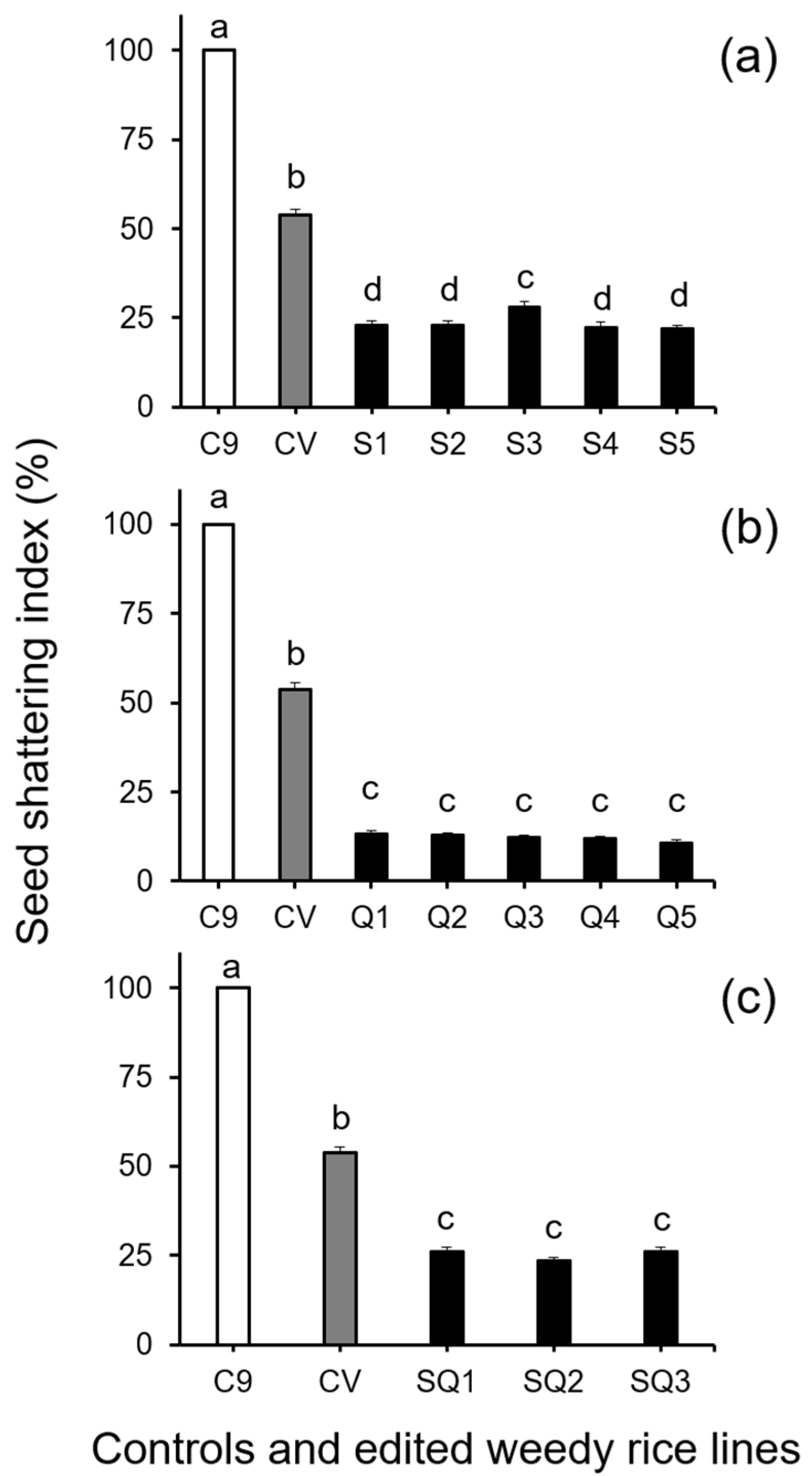


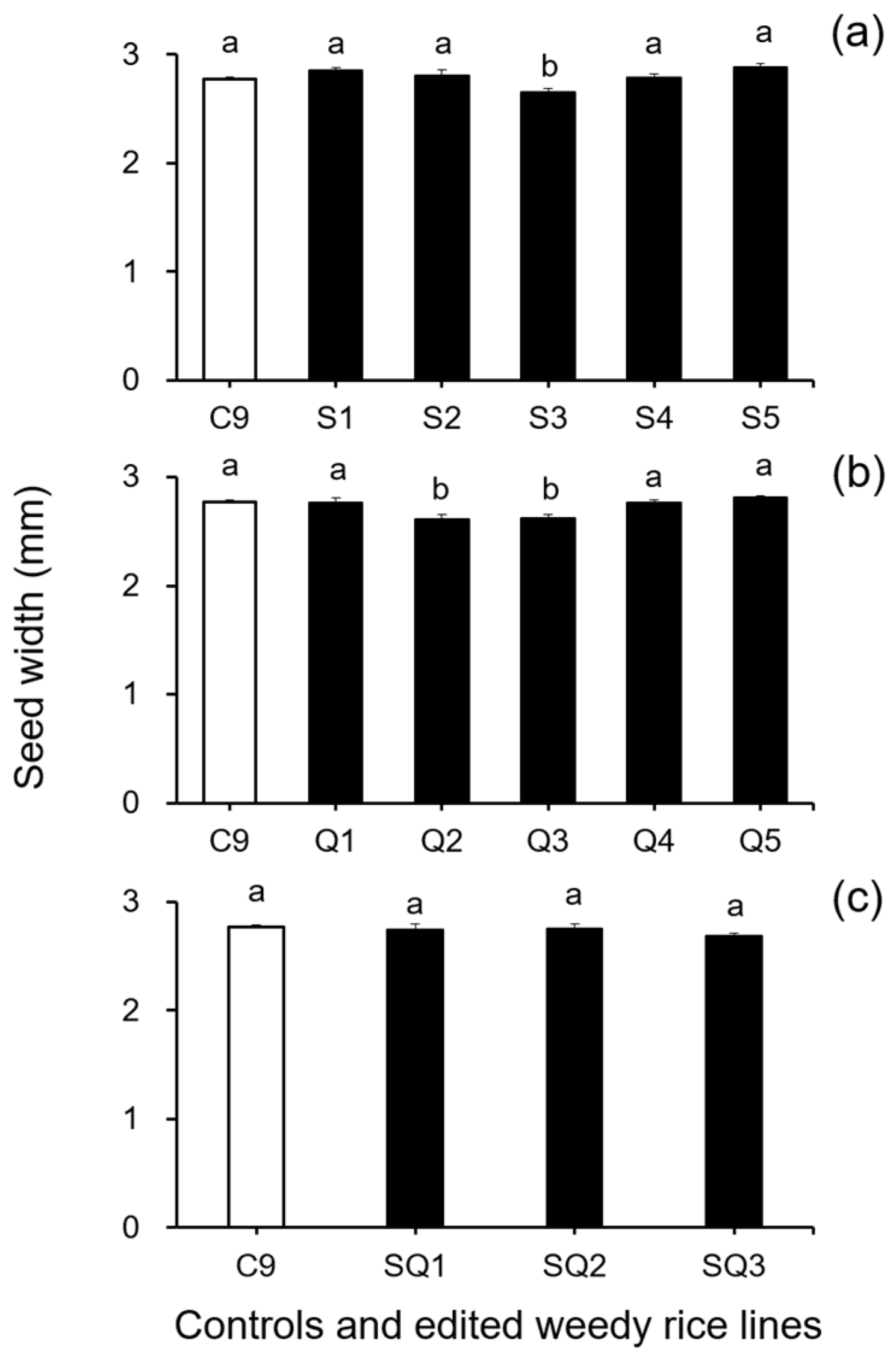


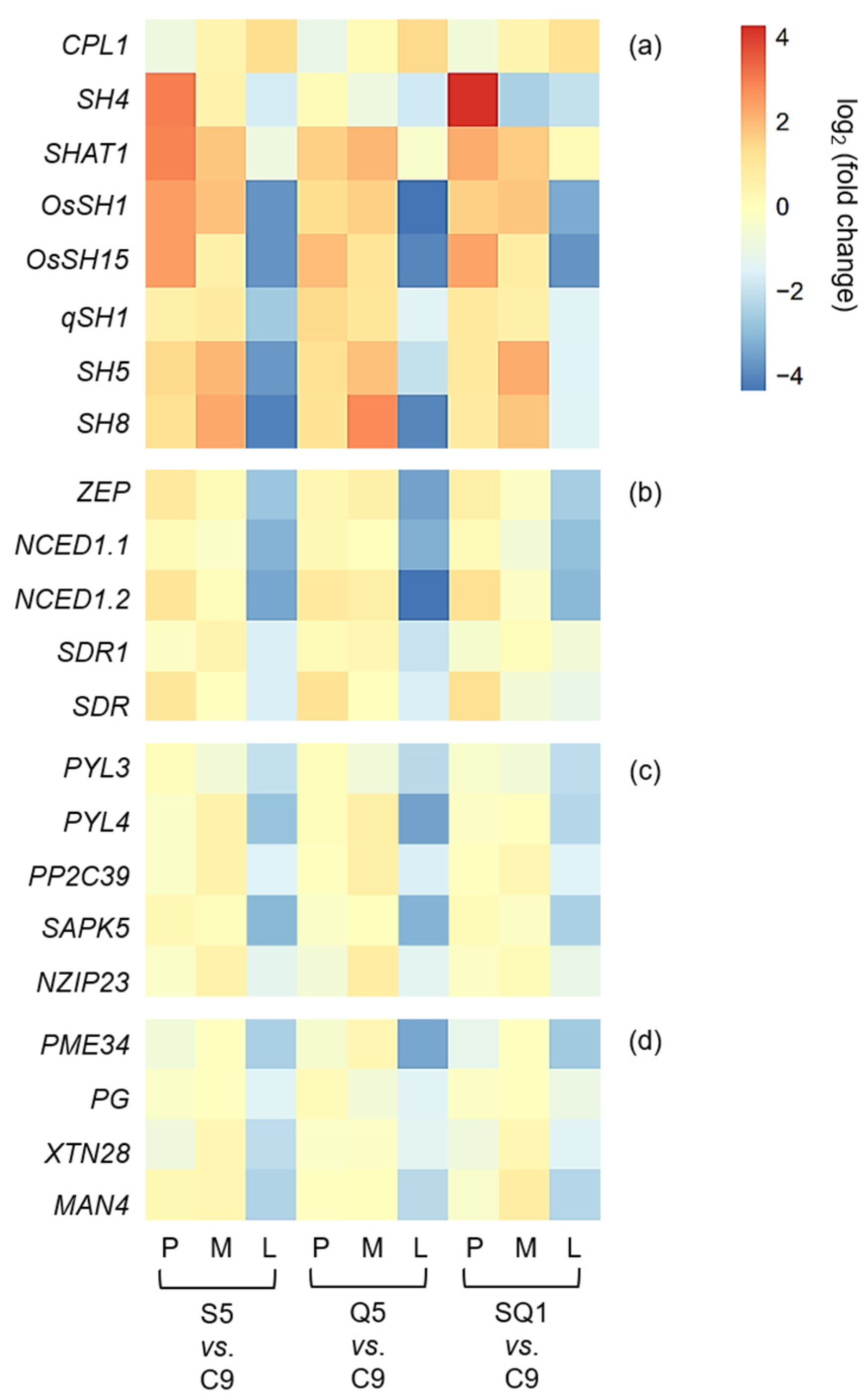
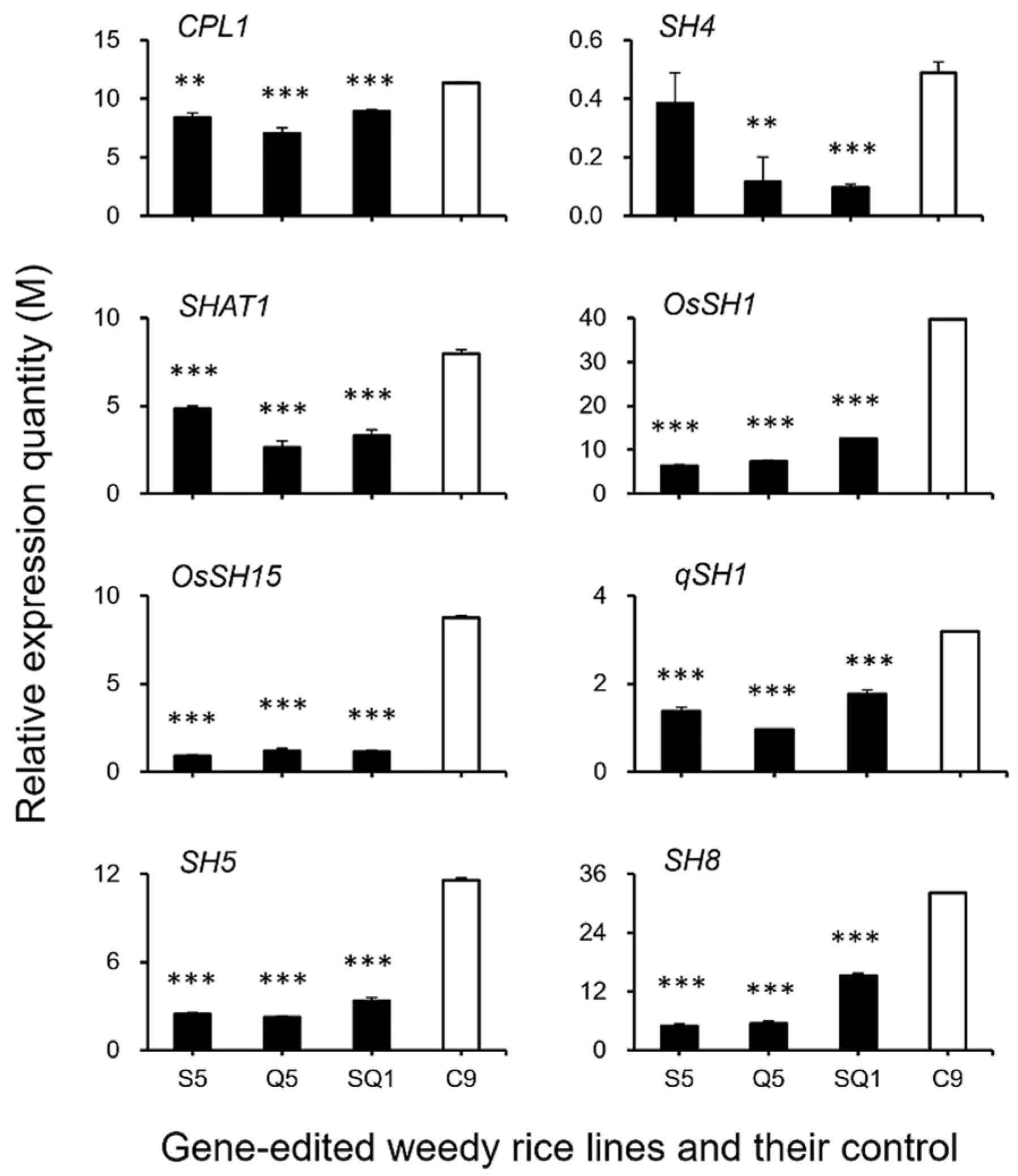
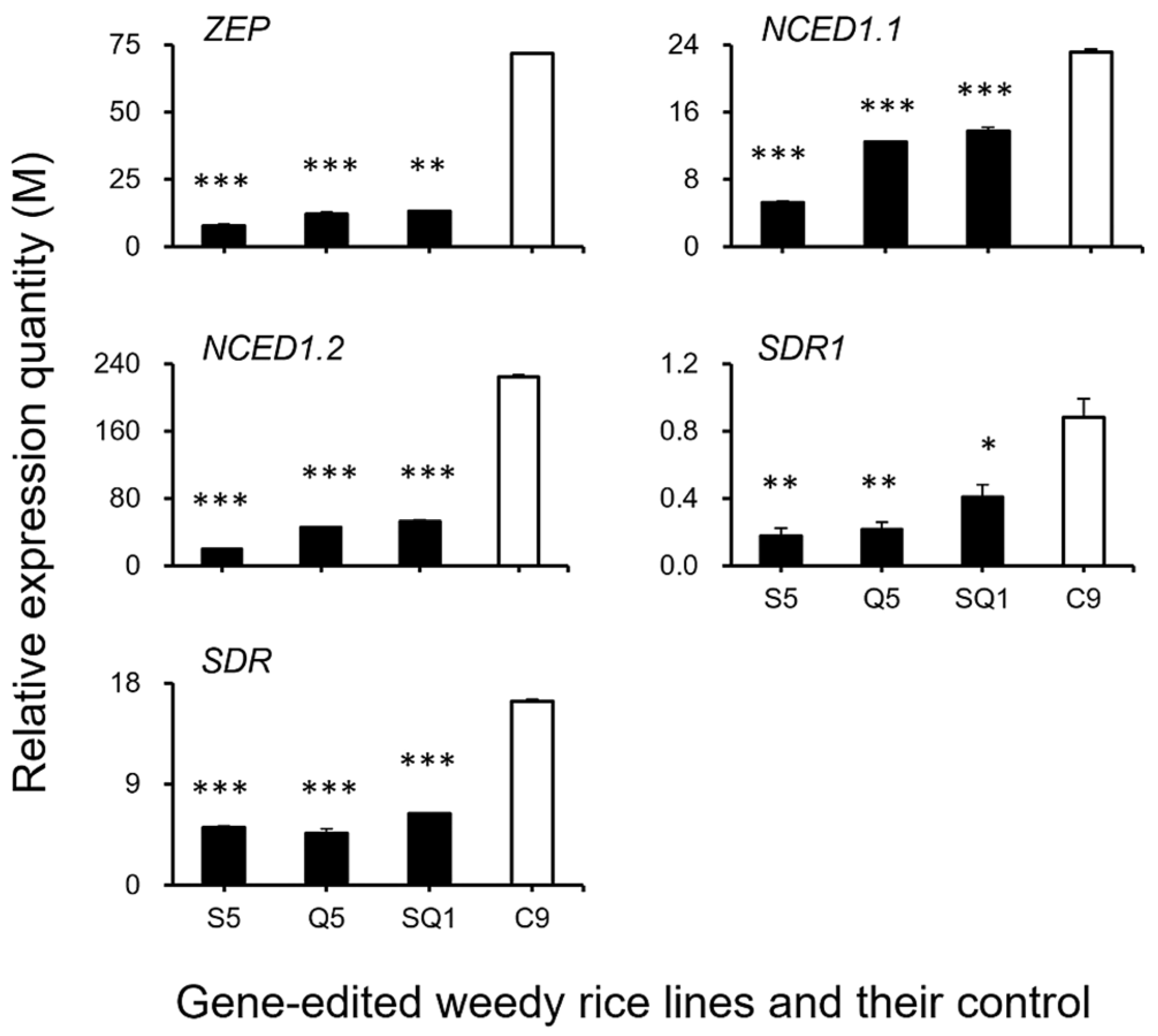
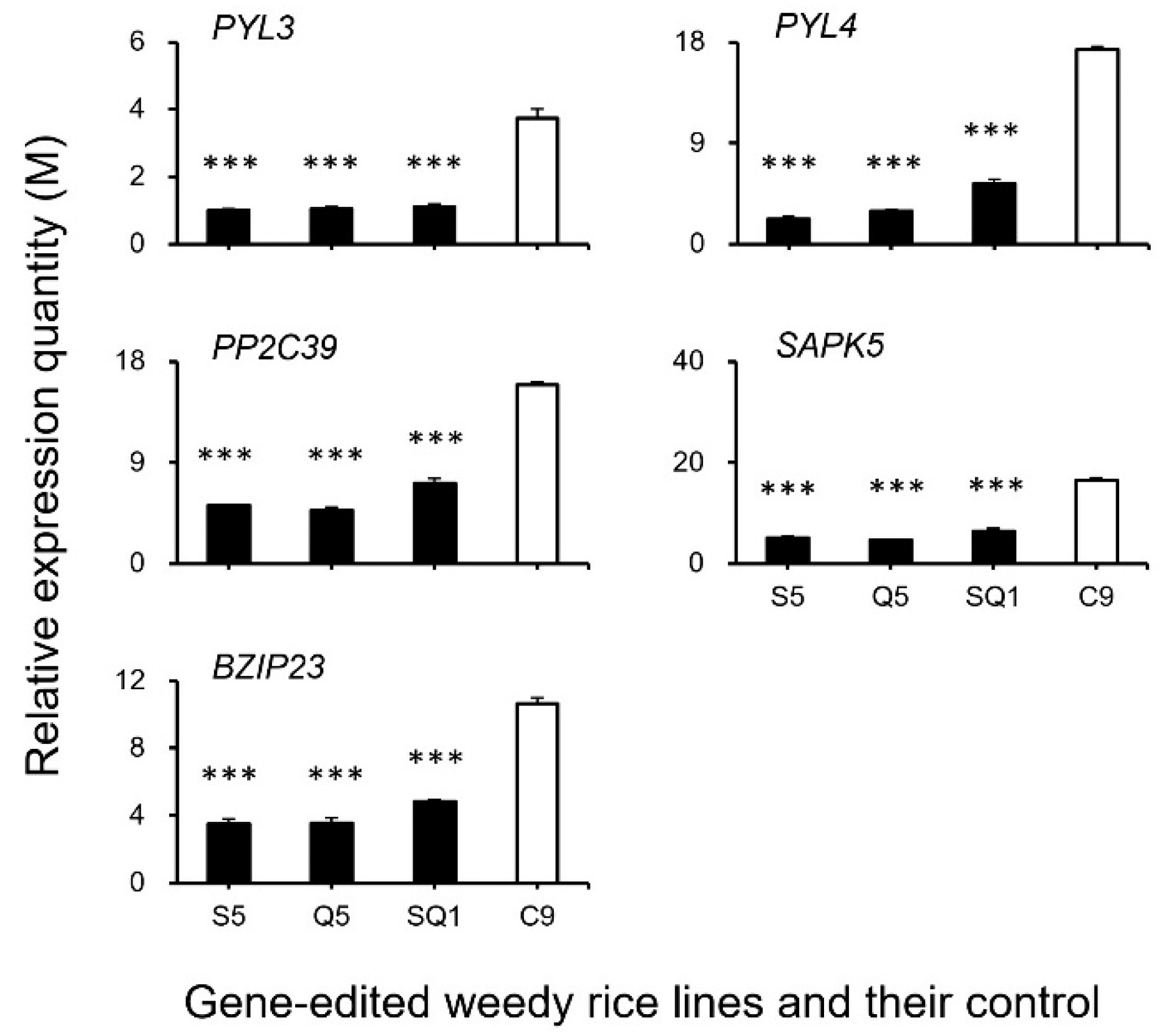
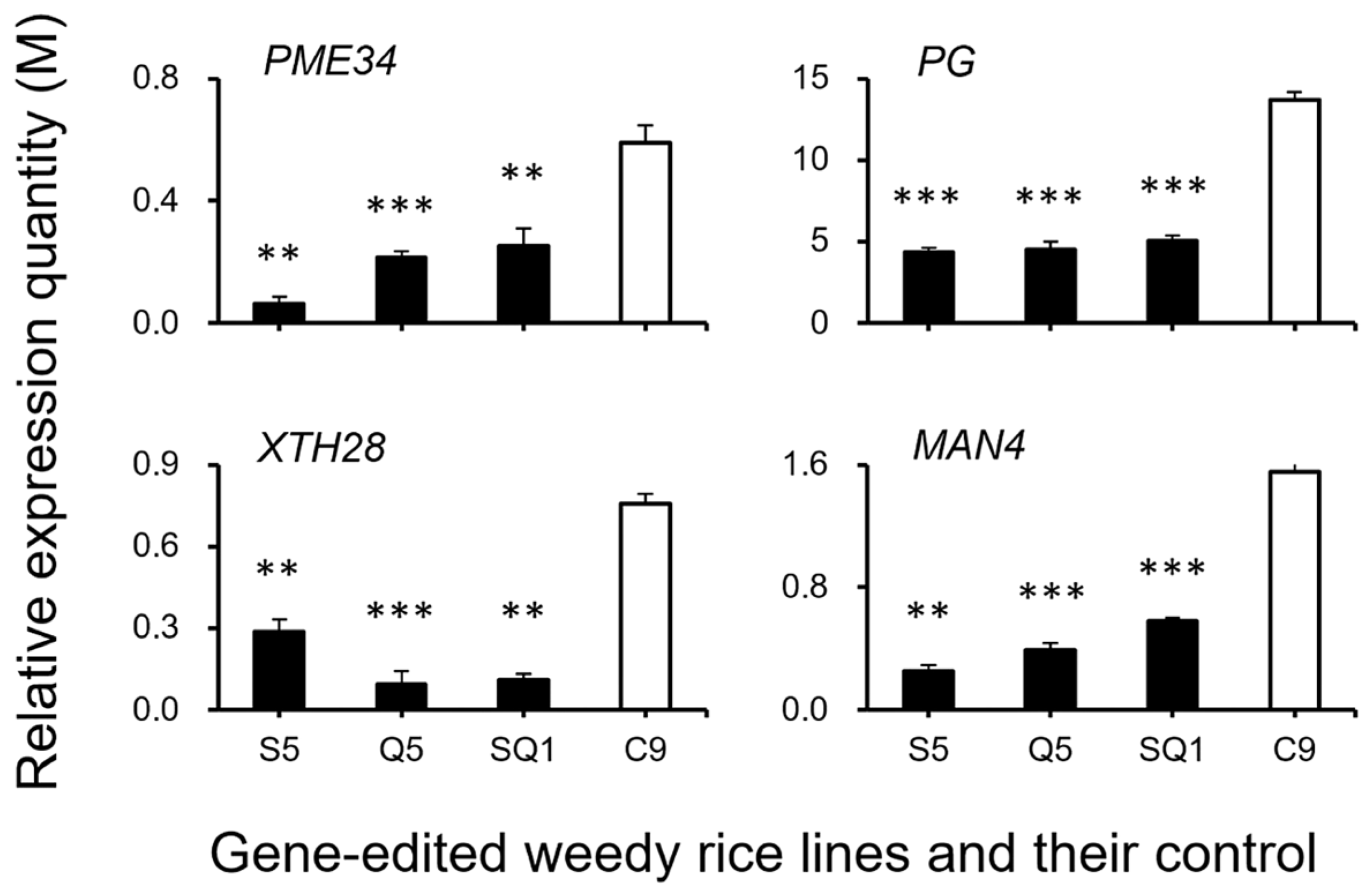
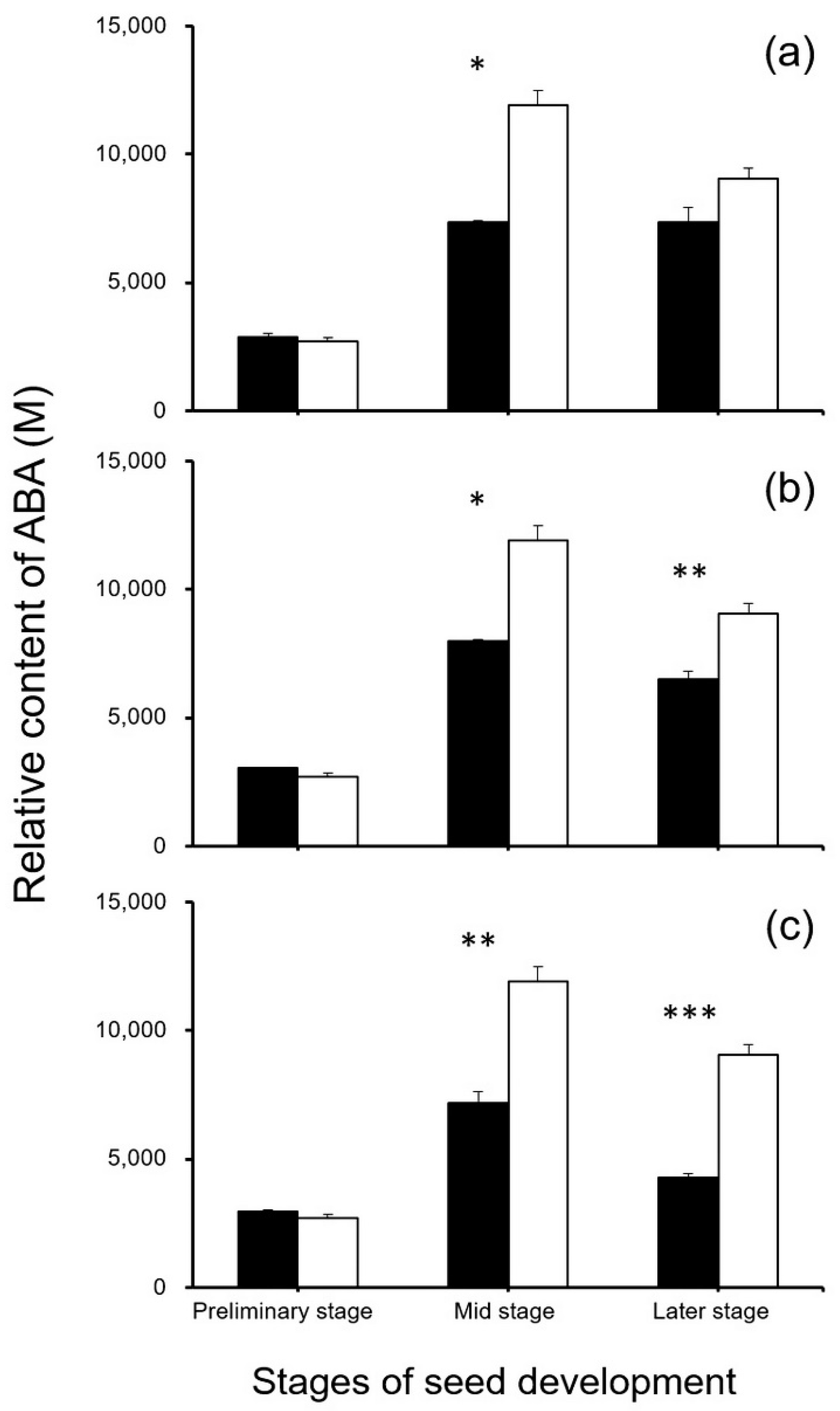
| Edited Gene | ID of Gene-Edited Lines | Variation on the Edited Locus | |
|---|---|---|---|
| SH4-TL-a | SH4-TL-b | ||
| S1 | 7 bp deleted | 15 bp deleted | |
| S2 | 245 bp deleted | No variation | |
| SH4 | S3 | T added | No variation |
| S4 | A added | No variation | |
| S5 | G deleted | No variation | |
| qSH1-TL-a | qSH1-TL-b | ||
| Q1 | 564 bp deleted | No variation | |
| Q2 | T added | A added | |
| qSH1 | Q3 | T added | C added |
| Q4 | 28 bp deleted | C deleted | |
| Q5 | No variation | C deleted | |
| SH4-TL-a | qSH1-TL-b | ||
| SQ1 | 439 bp deleted | C deleted | |
| SH4/qSH1 | SQ2 | 153 bp deleted | A added |
| SQ3 | 10 bp deleted | T added | |
| Factor | Df 1 | Traits | |||
|---|---|---|---|---|---|
| Seed Shattering Index (%) | 1000-Seed Weight (g) | Seed Length (mm) | Seed Width (mm) | ||
| F-Value | F-Value | F-Value | F-Value | ||
| Editing the SH4 gene | 1 | 3017.3 *** | 0.7 | 410.6 *** | 0.3 |
| SH4-gene edited lines | 4 | 3.3 * | 4.7 ** | 0.1 | 4.2 ** |
| Editing the qSH1-gene | 1 | 12,595.0 *** | 0.0 | 19.8 *** | 3.4 |
| qSH1-gene edited lines | 4 | 1.5 | 21.9 *** | 1.5 | 5.8 *** |
| Double editing (SH4/qSH1) | 1 | 3179.1 *** | 46.4 *** | 438.7 *** | 1.5 |
| SH4/qSH1-gene edited lines | 3 | 1.2 | 2.2 | 0.823 | 0.6 |
Publisher’s Note: MDPI stays neutral with regard to jurisdictional claims in published maps and institutional affiliations. |
© 2022 by the authors. Licensee MDPI, Basel, Switzerland. This article is an open access article distributed under the terms and conditions of the Creative Commons Attribution (CC BY) license (https://creativecommons.org/licenses/by/4.0/).
Share and Cite
Zhang, Y.-L.; Xia, Q.-Y.; Jiang, X.-Q.; Hu, W.; Ye, X.-X.; Huang, Q.-X.; Yu, S.-B.; Guo, A.-P.; Lu, B.-R. Reducing Seed Shattering in Weedy Rice by Editing SH4 and qSH1 Genes: Implications in Environmental Biosafety and Weed Control through Transgene Mitigation. Biology 2022, 11, 1823. https://doi.org/10.3390/biology11121823
Zhang Y-L, Xia Q-Y, Jiang X-Q, Hu W, Ye X-X, Huang Q-X, Yu S-B, Guo A-P, Lu B-R. Reducing Seed Shattering in Weedy Rice by Editing SH4 and qSH1 Genes: Implications in Environmental Biosafety and Weed Control through Transgene Mitigation. Biology. 2022; 11(12):1823. https://doi.org/10.3390/biology11121823
Chicago/Turabian StyleZhang, Yu-Liang, Qi-Yu Xia, Xiao-Qi Jiang, Wei Hu, Xiao-Xue Ye, Qi-Xing Huang, Si-Bin Yu, An-Ping Guo, and Bao-Rong Lu. 2022. "Reducing Seed Shattering in Weedy Rice by Editing SH4 and qSH1 Genes: Implications in Environmental Biosafety and Weed Control through Transgene Mitigation" Biology 11, no. 12: 1823. https://doi.org/10.3390/biology11121823
APA StyleZhang, Y.-L., Xia, Q.-Y., Jiang, X.-Q., Hu, W., Ye, X.-X., Huang, Q.-X., Yu, S.-B., Guo, A.-P., & Lu, B.-R. (2022). Reducing Seed Shattering in Weedy Rice by Editing SH4 and qSH1 Genes: Implications in Environmental Biosafety and Weed Control through Transgene Mitigation. Biology, 11(12), 1823. https://doi.org/10.3390/biology11121823









